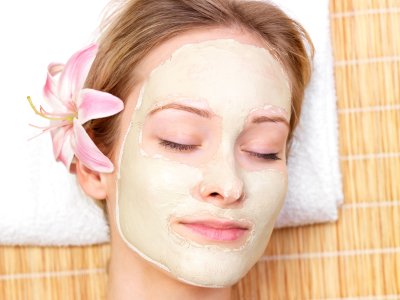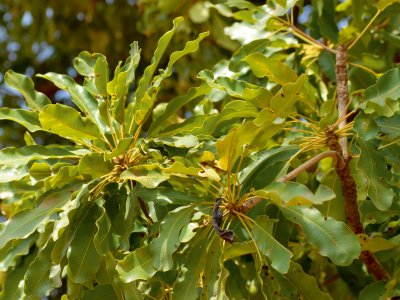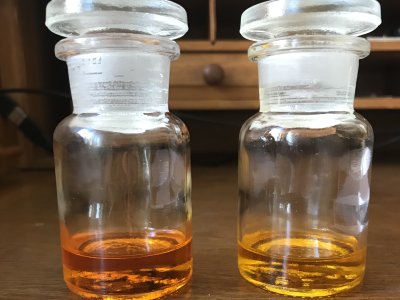Aroma & Clay Therapy

AROMA- & CLAY THERAPY
by R.Ypma
Reviewed by Martin Watt.
I have not investigated the suggestions made for treating animals or many of the claims for the clay treatments. While being perfectly happy that clay used externally has some useful properties, it should NOT be recommended for INTERNAL use by aromatherapists who do not receive a sound training in physiology or medicine. We do not know if the clay being offered has been subjected to formal testing procedures for microbial contamination or other pollutants.
The writer displays an extremely poor knowledge of the way plants produce aromatic materials, on the methods of extracting oils and on the botanical naming of the plants concerned.
Blue text are from the book. Black are my comments.
Page 11.
"essential oils were used as a means of payment in ancient times".
Concentrated essential oils were NOT used in ancient times.
"Romans and Greeks made fine perfumes from essential oils,"
They did not have distilled "essential oils", only fragrant plant extracts which included only tiny amounts of the plants essential oil.
Page 12.
"Bath houses"
Essential oils mentioned again, not true.
Page 15.
"Essential oils--"circulate through the plant carrying their specific properties".
Most essential oils do NOT circulate around the plant, but are stored in trichomes on the leaves, or in secretory vesicles.
"The condition of the plant controls the quality of the oil".
This is not strictly correct as the main thing controlling the quality of an oil is the extraction techniques. Essential oils often have little to do with the vitality of the plant, because you actually get higher levels of oil in many DEAD plants.
"Pressing is commonly used for citrus fruits,"
It is NOT, the bulk of citrus oils are distilled.
"Steam distillation works as follows";
The technique described is Ancient history and clearly the author had no knowledge of this process.
Page 17.
"Dr. Shuller in Berlin,"
No reference is given to this work and if oils are applied to the skin then of course they are inhaled.
"Reach the kidney within 1 hour of being applied to the skin,"
During that time the oil is being inhaled and that is how they would end up being excreted in the urine.
"Oil is very easily absorbed by persons with a high level of sebaceous gland activity as these glands are a conduit for the oil."
Completely without foundation.
"The active elements are etc."
Included are alkaloids that do not occur in essential oils (other than in trace amounts) as they are NOT volatile compounds.
Page 18.
Antiviral effects given for of a range of oils.
The only tests of antiviral activity that I have seen, have been in-vitro testing and this cannot be taken as evidence that the same action will occur in-vivo. I would also like to know of evidence that essential oils "stimulate the white lymph nodes."
Page 22.
"Cinnamon bark oil can be cut with cinnamon leaf oil".
Yes, it is possible, but you can smell the eugenol.
Page 23.
"pesticides and insecticides can be detected on a chromatography,"
It requires specialised analysis far beyond the normal chromatographic analysis of essential oils to detect the few parts per billion of such residues present in essential oils. You cannot tell from chromatography if oils are organically grown as she claims.
"The essential oil must be obtained by steam distillation or cold pressing."
This is inaccurate as the best quality oils are obtained by cold extraction methods. These give an olfactory and chemical profile far closer to that of the 'oil' in the living plant. It is though a common error in most aromatherapy books.
Page 34.
Claims that breast engorgement, intestinal parasites and vaginal infections can be treated via the external use of essential oils.
These claims are ludicrous, unjustified and potentially harmful if they do not work.
Page 35.
"I hear terrible stories about the effects of using oils internally,".
She should know that is exactly the method by which vast quantities are used in food flavouring. In addition, common carminatives such as peppermint, spearmint, fennel. etc. are far safer used internally than the CLAY which she is recommending. The real issue is volume used and if the oil is genuine which many are not.
Page 36.
"most aromatherapy books having been copied from each other without the writers having any sound knowledge."
I absolutely agree, but this book certainly does not display any sound knowledge.
"dosage in drops because with essential oils that would be accurate."
In fact, drops is the most unreliable method of measuring oils due to the huge variations in dropper size and viscosity variations.
Page 37.
"Epilepsy; avoid anise, rosemary and fennel."
There is no sound data to support this view, all are permitted food flavourings.
Page 43.
"Asthma; for bathing 10 tablespoons of clay and 20 drops of Thyme oil."
That is roughly 1 ml. of thyme oil in the bath enough to cause severe skin irritation and possibly burning of the skin.
Suggesting people treat angina pain with self help remedies.
This is seriously dangerous advice as no reference is made to seeing a doctor.
Page 44.
"for more than one bath warm 100ml. coconut oil and add 100ml. (15 drops) of the essential oils."
I can only presume this is a typographical error. Very greasy bath!!!
References to high blood pressure with no mention of consulting a doctor.
Breast feeding; to reduce milk flow, a complicated formula including SAGE oil.
It is only the herbal extract that does this NOT the essential oil.
Page 49.
"Caries; for mouthwash mix 25 ml. vodka with 10 drops of cinnamon,(It does not say if cinnamon bark or leaf)10 drops of clove etc. put mixture in a glass of warm water and rinse teeth."
She has already said that oils and water do not mix and by diluting the alcohol in the water the essential oils will come out of suspension. At this level of use it could cause very severe irritation, particularly if cinnamon bark oil were used.
Page 50.
Cholesterol to lower; massage the whole body daily with...100ml avocado and 100 drops (=5ml) of rosemary oil.
To lower cholesterol, she has got to be joking. The problem with such silly suggestions is that people are likely to try them and delay going to see their doctor. Also, the volume of rosemary oil is outrageous.
Page 50.
Circulation; enormously high levels of oils including 20 drops of Sassafras, banned in the country in which she wrote this book.
Page 55.
Eczema; suggesting a few drops of sassafras are used. With the damaged skin of eczema, the safrole will be readily absorbed. This oil is effectively banned throughout the whole of the European Community in cosmetic products, because of fears over it's carcinogenicity. So use its use on damaged skin is OK is it !!
Page 56.
Fainting; "sprinkle a few drops of cinnamon onto a handkerchief and allow them to inhale deeply." If she means cinnamon bark, this would cause agonising pain on the nose and could cause burning. I do wish such writers would try out what they suggest others should do!
Page 58.
Fungal infections; says petigrain is anti-fungal and gives the impression that cinnamon can be used as a substitute (50 drops), this does not bear thinking about if such a mixture was put on the sore tissue of athlete's foot.
Page 60.
Frostbite; I thought this was a condition for hospital treatment, not one for people to treat themselves using clay poultices.
Gallbladder stone; suggests that "during an attack a light massage around the gall bladder might help."If a gall stone is causing pain it is likely that it is because either infection is present, that it is stuck in the bile duct, or that sharp edges are causing tissue damage. In either case, you do not want any chance of moving the stone or infection further by massaging.
Page 61.
Gout; Sassafras-see page 55 above.
Haemorrhage; a formula suggested, but no mention as to the origin or
nature of the haemorrhage. Cypress oil is NOT an astringent as she seems to be suggesting in common with most other aromatherapy authors.
Hair lotion; 75% proof alcohol, you can't normally obtain that strength. When mixed with equal parts of water this reduces the level of alcohol below that which many oils will disperse in.
Page 65.
Hayfever; sniff up some highly irritating oils.
Heart tremors; definitely one for the doctor, but no mention made of that.
Page 67.
To strengthen the immune system; bath twice a week with 20 drops of tea tree oil (that's 1 ml. of tea tree in the bath!!!), also suggests a fortnightly massage using tea tree. If done regularly this could initiate a sensitisation reaction and it's ability to strengthen the immune system is very doubtful.
Page 69.
Kidneys: for detoxification; what on earth is a toxic kidney ? Again a severe life threatening condition not for self treatment.
Page 73.
"WILD ROSE" what's that, no such essential oil exists.
Page 74.
Mouthwashes; suggesting 3 drops of Sassafras - see page 55 above.
Page 79.
To promote perspiration; 15 drops of Sassafras - see page 55 above.
Page 80.
Pregnancy nausea; recommendation to drink the clay powder. It is not known if this product has undergone testing for its suitability as an internal medicinal agent. The tubes do not state if they contain a preservative, therefore we do not know if it may harbour bacterial contamination or what. Update 1998, such a product sold without full testing in the EEC is now illegal.
Page 81.
Post natal depression; 50 drops of rose oil ?? Wow think of the cost!
Psoriasis; 10 drops of Sassafras (see eczema).
Page 82.
Cancer pre treatment; she is suggesting massage before treatment. This is controversial as it could cause lymphatic or venous spread of carcinogenic cells.
Page 86.
Firm, resilient skin; the level of oil is equal to 5% this is fine for some oils, but is far to high for certain oils.
Page 90.
Smoker's leg; the total oil concentration comes out to 16.25% which is far too high.
Sunburn; 5 drops of peppermint, all that will do is cause a temporary numbness of the skin followed by possible irritation.
Page 91.
Caries using clay. Crazy, clay is water soluble and will wash out.
Page 92.
Sore throats; clay wrap around the throat "draws the catarrh into the clay"? What through the skin, wow magic!!!
Page 93.
Thyroid gland underactive; no mention about a medical consultation, or any treatment suggested here possibly affecting existing conventional medication.
Tingling in arms and legs; this could be a prelude to a heart attack and no mention is made of consulting a doctor.
Page 95.
Ulcers; "once the ulcer has burst" use sassafras oil VERY DANGEROUS.
Urinary disorders and difficult urination; no mention made of getting a medical diagnosis in case it is prostatic cancer.
Page 96.
Uterine problems; "infections of the neck of the womb"-no mention of this being properly diagnosed. "3 tablespoons of clay used as a douche." Clay is an inorganic material which the body can not break down, if any were retained in the vagina it is highly likely to lead to irritation and may even find it's way to more hazardous areas such as the uterus. It is known that talc has been found in the ovaries without knowing how it got there.
Page 97.
Varicose veins "massage around the veins". It does not say massage GENTLY. All the aromatherapy training bodies say that varicose veins are "contra indicated for massage".
Page 99.
Worms; this is a condition for professional treatment and it is doubtful if clay alone will kill or remove such parasites.
Page 119.
BIRCH; "purifies the blood" what on earth does that mean. This is an old fashioned concept for which there is no place in modern complimentary medicine.
CHAMOMILE; given the name "Chamaemelum mixta" this name is totally incorrect even for chamomile morocc (which it sounds like she means) and which chemically and in every other respect differs from Roman chamomile.
CINNAMON; does not state bark or leaf, but looks like she means bark oil which an extremely hazardous substance.
EUCALYPTUS; "blood purifier" see comments under Birch.
Page 120.
GERANIUM; the botanical name is incorrect.
"oedema and diuretic, urinary tract disorders" this is extremely doubtful, I have seen no information suggesting such an action from the EXTERNAL use of this oil.
MYRRH; uterine disorders; what from EXTERNAL application ???
NIAOULI; tissue regenerating ? evidence please.
NUTMEG OIL; diarrhoea! this is a classic example of the internal use of the herb being transferred to the use of the oil and is totally incorrect.
Page 121.
SASSAFRAS is effectively banned in cosmetics throughout the E.E.C. It is banned for use in foods.
TEREBINTH; two of the suggested uses would only work following INTERNAL consumption.
WILD ROSE; stated to be "Rosa centifolia," this variety is CULTIVATED for aromatic extracts. NO WILD ROSE ABSOLUTE OR ESSENTIAL OIL IS AVAILABLE ANYWHERE IN THE WORLD.
Further reading.
This contains all the classic aromatherapy works which all contain numerous errors of fact. Not a single research reference is given which indicates that this author has not studied any of the vast amounts of research that is available on aromatic extracts.
SUMMARY.
This book contains some very hazardous information on the volumes of essential oil use. It also recommends using some very dangerous essential oils. It most definitely should not be available to the general public and in my opinion possess some substantial hazards if therapists use the information without thinking about its accuracy.
In my opinion, this book - although quiet old - displays a typical lack of knowledge among early aromatherapy authors on what they were writing about.
Source and copyright: http://www.aromamedical.org


